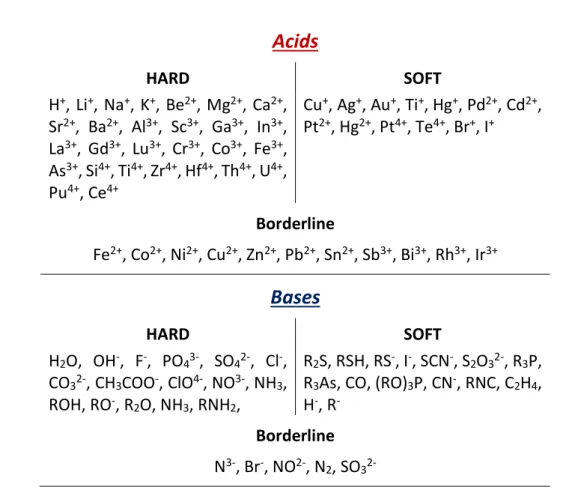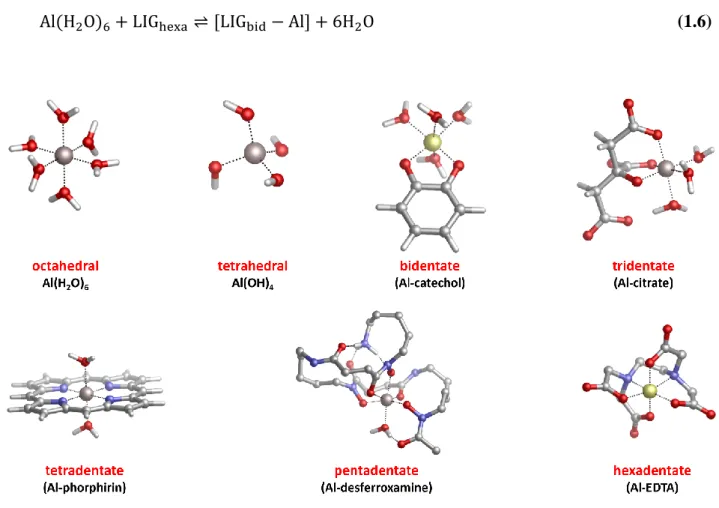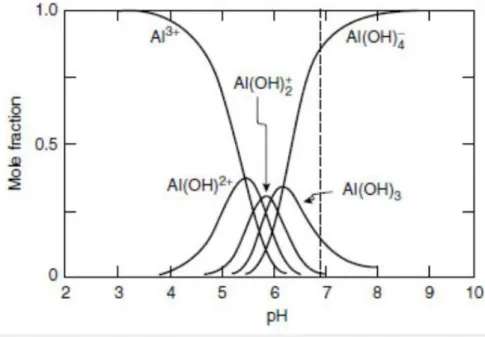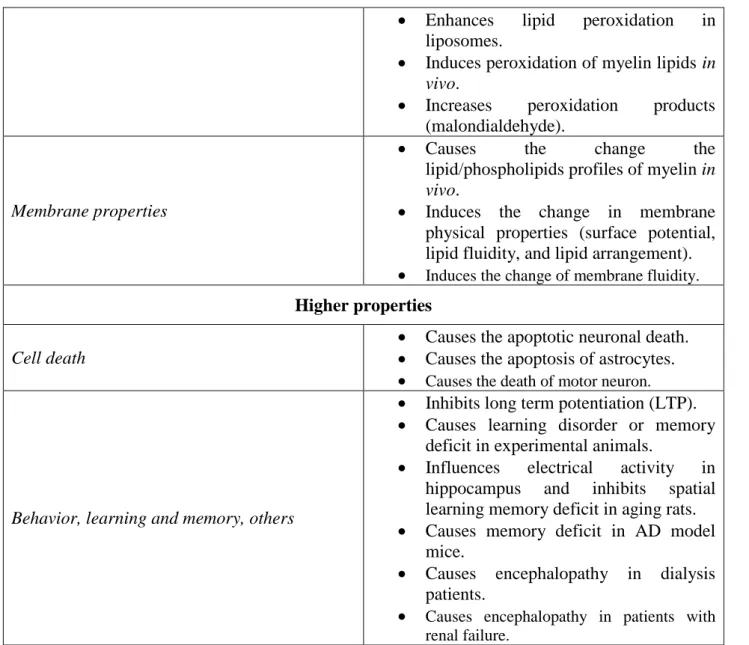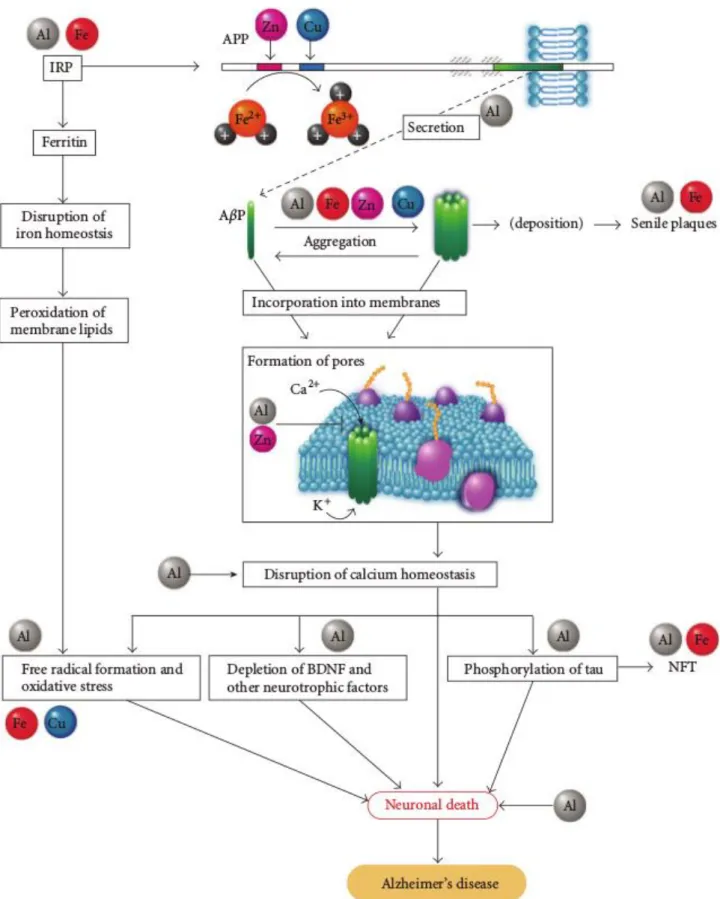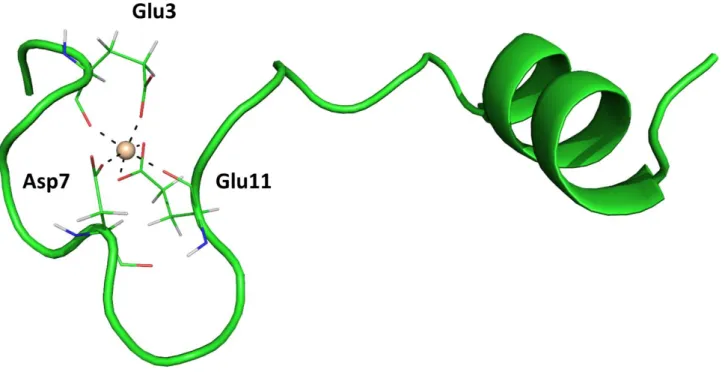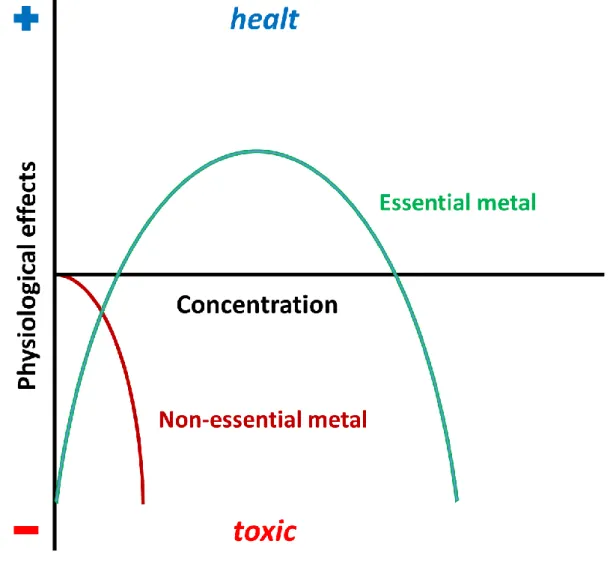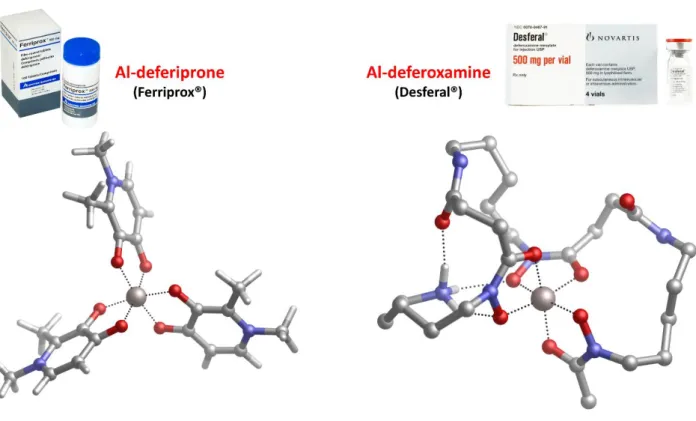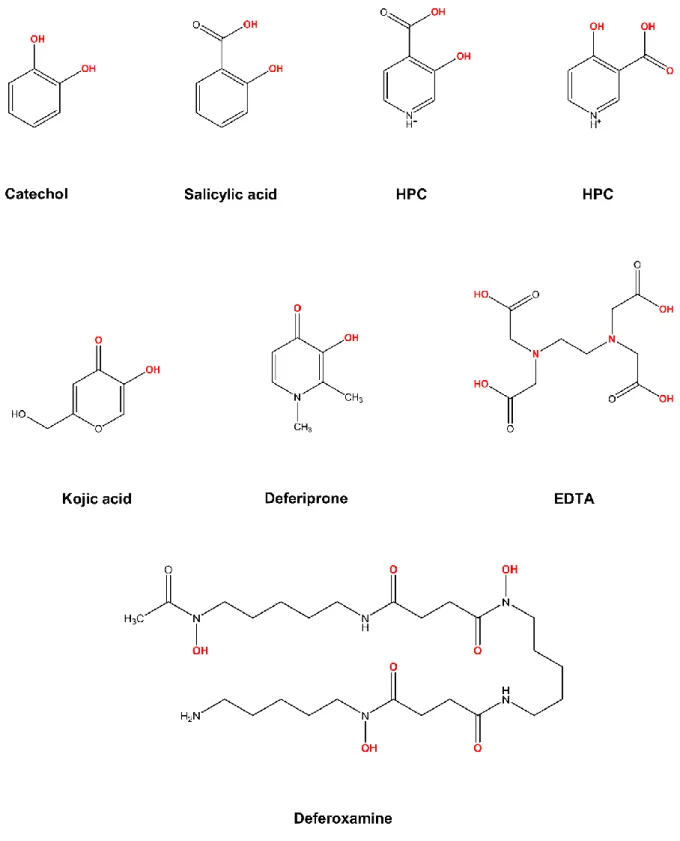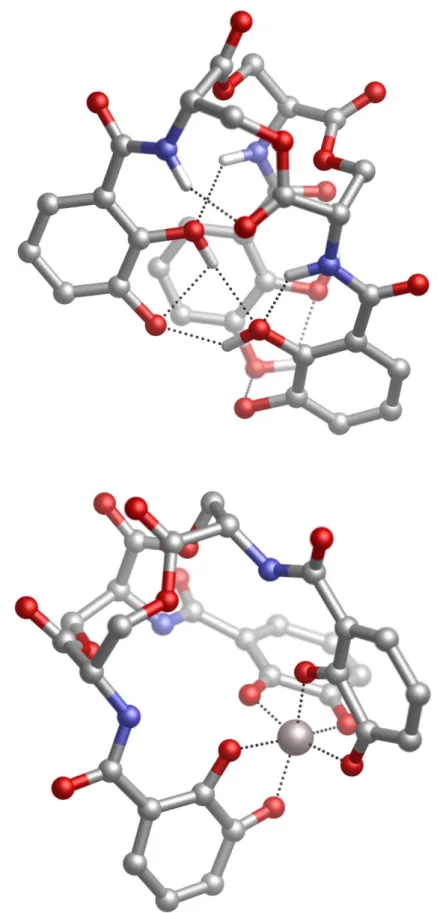biochemistry and development of new
chelation strategies
Supervisor: Prof. Xabier Lopez Gabriele Dalla Torre
Supervisor: Prof. Maria João Ramos
2019
(ITN-EJD-TCCM)
Organized by the Autonomous University of Madrid
Computational approach to aluminum biochemistry and
development of new chelation strategies
The work has been carried out in the following Institutions (two Academia and one
private company), as part of the Marie Sklodowska-Curie Actions – Innovative
Training Networks (MSCA-ITN, grant agreement N.642294-TCCM):
1. Euskal Herriko Unibertsitatea (University of the Basque Country and Donostia International Physics Center, Spain – 16 months).
Supervisor: Prof. Xabier Lopez.
2. SmartLigs® Bioinformatica S.A. (Madrid, Spain – 4 months). Supervisor: Dr. Almudena Perona.
3. Universidade do Porto (University of Porto and UCIBIO, Portugal – 16 months). Supervisor: Prof. Maria João Ramos.
(Dr. Joanna I. Lachowicz).
This project is part of the Horizon 2020 Research and Innovation programme
funded by the European Union
Yeah just sittin' around waitin' for my life to begin While it was all just slippin' away
I'm tired of waitin' for tomorrow to come Or that train to come roarin' 'round the bend
I got a new suit of clothes a pretty red rose And a woman I can call my friend
These are better days baby Yeah there's better days shining through
These are better days baby Better days with a girl like you Well I took a piss at fortune's sweet kiss
It's like eatin' caviar and dirt
It's sad funny ending to find yourself pretending A rich man in a poor man's shirt
Now my ass was draggin' when from a passin' gypsy wagon Your heart like a diamond shone
Tonight I'm layin' in your arms carvin' lucky charms Out of these hard luck bones
These are better days baby These are better days it's true
These are better days
There's better days shining through Now a life of leisure and a pirate's treasure
Don't make much for tragedy
But it's a sad man my friend who's livin' in his own skin And can't stand the company
Every fool's got a reason for feelin' sorry for himself And turning his heart to stone
Tonight this fool's halfway to heaven and just a mile outta hell And I feel like I'm comin' home
These are better days baby There's better days shining through
These are better days Better days with a girl like you
These are better days baby These are better days it's true
These are better days Better days are shining through”
biochemistry and development of new
chelation strategies
Thesis dissertation by
Gabriele Dalla Torre
January 1, 2019
Schio
1
Acknowledgements
Too many people to thank, really too many. This should mean that a lot of people have crossed the long, windy road of my life.
Three years have gone too fast…
Beautiful people, funny jerks, great souls and lonely hearts.
May God know how, each of them, have improved, in some way, my knowledge, my strength, my faith and my happiness.
First of all, many thanks to Prof. Xabier Lopez, Prof.Maria Joao Ramos and Dr. Almudena Perona, my three supervisors, for givin’ me all the instruments that I need to going on with my scientific career, and to realize my ambitions.
And, of course, for the huge degree of patience.
Many thanks to all the Theoretical people of Xabi’s, Maria’s and Almudena’s group. A lot of guys, too many to remember all of them throughtout these years; I’m proud for having been working with you. Special mention goes to Joni Mujika, Elena Formoso (EHU), Eduardo Oliveria and Rui Neves (Uporto) and David (Smartligs); their help was priceless.
Thanks to Federica Amato, for shining on me like a blooming flower in the Badlands.
Thanks, obviously, to my parents, my family, my sister, my cousins and my relatives, because life can change and we are not stuck in vain.
And thanks to all the fuckers, as they taught me that I have one more reason to be a better person, to fly over the shadows, and, someday, the King of gloom will be forever doomed.
Finally, many thanks to all of you, for reading this manuscript. May the Force be with you.
5
Abstract
Aluminum is the third most abundant element on Earth’s crust, and the first metal. Nevertheless, its complex chemical features, mainly its low solubility, have prevented its utilization within the biological cycles of living organisms, leading to a not fully understood paradox from an evolutionary point of view1.
In the last Century, the acidification of the environment due to the human intervention, has allowed Al(III) to become one of the main components of our daily lives. It has become so highly (bio)available that some authors state that we are currently living “The Aluminum Age”2.
As a consequence of such massive human exposure to this non-essential metal ion, detrimental neurological effects have been reported, raising concerns about the potential toxic role of aluminum in the biological environment3. In particular, the link between the presence of Al(III) in neuronal
tissues and the development of Alzheimer’s Disease is a matter of debate and controversy, despite all the many efforts made in order to unveil the pathogenic effects of Al(III)4,5.
In this rather controversial context, the quest for reliable chelating agents that can efficiently remove Al(III) from the biological environment has attracted much interest in the last years6. The goal of chelation therapy is the development of chelating agents with a high affinity and specificity for a given metal ion, lack of toxicity and strong competitiveness with respect to endogenous metal ions and chelators. However, due to the complex chemistry of aluminum, a suitable and specific Al(III) chelating agent has not yet been found6.
Accordingly, we believe that a computational approach to aluminum biochemistry, by using state-of-the-art computational tools and in collaboration with experimental partners, would allow for a strong help towards a clearer understanding of the role and the behavior of Al(III) in the human organism. In this sense, the present PhD project has covered three main areas: i) chelation therapy and development of new chelation strategies. ii) Understanding of the potential toxic role of aluminum in the biological environment, considering different bioligands. iii) Validation and calibration of the accuracy of theoretical methods (mainly DFT) with respect to available experimental data and other high level benchmarks, in order to improve the reliability of our computational approach. Moreover, the work was carried out in close collaboration with experimental partners from the University of Cagliari (Italy).
6
A wide range of methods have been used for that purpose, such as cluster-continuum approaches at the DFT level of theory, thermodynamics of metal-ligand complexes in solution, chemical bond analysis, QM/MM simulations. The availability and fine understanding of experimental data has allowed the setup of a reliable computational protocol suitable for the investigation of Low-Molecular-Mass (LMM) aluminum chelators. Additionally, other methodologies were used during the secondment at SmartLigs®, such as classic MD simulations, docking and MonteCarlo-based conformational sampling techniques.
All results achieved so far are contained in the publications list along with the scientific production (e.g. conferences, meetings etc.), and will be presented and discussed in this Thesis dissertation.
9
Contents
Acknowledgements ... 1
Abstract ... 5
Chapter 1
INTRODUCTION ... 17
1.1 Living the “Aluminum Age” ... 18 1.1.1 What’s wrong with aluminum ? ... 18 1.1.2 The complex and unique (bio)chemistry of the aluminum ion and coordination principles ... 20
1.1.2.1 Hard and Soft Acids and Bases (HSAB) principle ... 20
1.1.2.2 Aluminum chelation principles and binding features ... 23
1.1.2.3 Aluminum speciation in solution ... 25 1.1.3 Is aluminum a (neuro)toxic element ? A (still) controversial topic ... 26 1.1.4 The (neuro)toxicity of aluminum and its link to Alzheimer’s Disease: an overview of the current status ... 30
1.1.4.1 Aluminum’s interaction with the biological environment ... 30
1.1.4.2 Aluminum and neurodegenerative diseases: towards a link with Alzheimer’s
____Disease ... 31
1.1.4.3 The amyloid cascade hypothesis ... 36 1.2 Chelation therapy ... 40 1.2.1 The goal of chelation therapy ... 40
1.2.1.1 Essential and non-essential metal ions ... 41 1.2.2 Al(III)-based chelating agents ... 42
1.2.2.1 The chelate effect ... 44
1.2.2.2 Al(III) chelating agents: the current status ... 45 1.2.3 Experimental criteria to evaluate the performance of a given chelator in solution ... 52
10
1.2.3.2 The pM parameter... 55 1.2.4 The dark side of Al(III) chelation therapy: challenges and perspectives ... 56 1.3 A computational approach to aluminum biochemistry ... 58 1.3.1 Thermodynamics of Al-ligand complexes in aqueous solution ... 58 1.3.2 Aim of the thesis ... 60
Chapter 2
METHODS ... 65
2.1 Potential energy surfaces ... 66 2.2 Density Functional Theory (DFT) ... 67 2.2.1 B3LYP ... 71 2.2.2 Range-separated DFT ... 72 2.2.3 London dispersion corrections ... 73 2.3 Basis sets ... 76 2.3.1 Basis Sets Superposition Errors (BSSE)... 78 2.4 Solvation ... 78
PART I:
Chelation therapy and development of new chelation strategies
Chapter 3
Tuning the affinity of catechols and salicylic acids toward Al(III):
characterization of Al-chelator interactions ... 85
3.1 Introduction ... 87 3.2 Methodology ... 88 3.2.1 Definition of binding affinities: cluster-continuum approach ... 90 3.2.2 Chemical bond analysis and evaluation of molecular properties ... 91 3.2.3 Aluminum ion and proton competition... 92 3.3 Results and discussion ... 93 3.3.1 Validation of binding affinities ... 93 3.3.2 Modulation of the binding affinities by electron donating and withdrawing groups ... 95 3.3.3 Chemical bond analysis of Al-chelator interactions ... 98
11
3.3.3.1 QTAIM analysis suggests a mainly ionic interaction but with a sizeable covalent
___degree ... 98
3.3.3.2 Delocalization Indices show a strong correlation versus binding affinities ... 100
3.3.3.3 Energy decomposition analysis confirms a mainly ionic bond with a significant
___covalent character that modulates the binding affinity ... 102 3.3.4 The role of aromaticity ... 102 3.3.5 Proton and aluminum ion competition ... 105 3.3.6 Tuning the molecule: the role of substituents ... 110 3.4 Conclusions ... 113
Chapter 4
Design of new efficient chelators of aluminum based on Mimosine-containing
peptides ... 115
4.1 Introduction ... 116 4.2 Methodology ... 118 4.2.1 Systems set-up ... 118 4.2.2 Molecular dynamics simulations ... 119 4.2.3 Relative binding energies ... 121 4.2.4 Electron delocalization indices ... 122 4.3 Results ... 122 4.3.1 Structural stability of the first Al(III) coordination shell... 124 4.3.2 Al(III) coordination mode ... 127 4.3.3 Electronic structure of Al(III) coordination shell ... 129 4.3.4 Relative Stability of the Al-Pept complexes ... 131 4.3.5 Comparison with defriprone ... 133 4.4 Conclusions ... 134
PART II:
Understanding the potential toxic roles of Al(III) in the biological
environment
12
Aluminum’s preferential binding site in proteins: sidechain of amino acids versus
backbone interactions ... 140
5.1 Introduction ... 140 5.2 Methodology ... 141 5.3 Results ... 142 5.3.1 Interaction with the backbone of proteins ... 143 5.3.2 Interaction with amino acid sidechains ... 148 5.4 Conclusions ... 150
Chapter 6
Aluminum and Fenton reaction: how can the reaction be modulated by
speciation? A computational study using citrate as a test case ... 154
6.1 Introduction ... 154 6.2 Methodology ... 156 6.3 Results and discussion ... 158 6.3.1 Incorporation of the O2· superoxide radical ... 158
6.3.2 Fenton reaction ... 162 6.3.3 Delocalization Indices and ligand affinity ... 165 6.4 Conclusions ... 169
Chapter 7
The interaction of aluminum with catecholamine-based neurotransmitters: can
the formation of these species be considered a potential risk factor for
neurodegenerative diseases? ... 172
7.1 Introduction ... 172 7.2 Methodology ... 175 7.2.1 Cluster-continuum approach ... 175 7.2.2 Definition of binding affinities ... 175 7.2.3 Al-ligand formation energies ... 177
13
7.2.4 pAl calculation ... 178 7.2.5 QTAIM and Delocalization Indices (D.I.) ... 178 7.2.6 Energy Decomposition Analysis (EDA) ... 179 7.3 Results and discussion ... 179 7.3.1 Binding affinities of 1:1, 1:2 and 1:3 Al-catecholamines with respect to reference catechol ... 179 7.3.2 Analysis of Al-O bonds ... 184 7.3.3 Aluminum ion/proton competition for ligand binding ... 185 7.3.4 Comparison between different ligands towards aluminum binding and aluminum hydroxide formation in solution ... 187 7.4 Biological implications of the results ... 190 7.5 Conclusions ... 195
Chapter 8
SCIENTIFIC IMPACT OF THE PROJECT ... 199
8.1 Training schools and international courses ... 200 8.2 International conferences and workshops contributions ... 201 8.3 Outreach activities ... 202 8.4 Publications ... 203 8.5 Awards... 204
Chapter 9
CONCLUSIONS ... 207
9.1 Concluding remarks ... 208 9.1.1 Chelation therapy and development of new chelation strategies ... 208 9.1.2 The potential toxic role of aluminum in the biological environment ... 209 9.1.3 Improvement and calibration of the theoretical methods ... 210 9.2 Future perspectives ... 212APPENDIX A ... 215
APPENDIX B ... 241
14
APPENDIX C ... 263
17
INTRODUCTION
“My name is Joe Roberts I work for the state I'm a sergeant out of Perrineville barracks number 8
I always done an honest job as honest as I could I got a brother named Franky and Franky ain't no good”
18
1.1 Living the “Aluminum Age”
1.1.1 What’s wrong with aluminum ?
Aluminum is the third most abundant element on Earth’s crust (8%) , after oxygen and silicon, and it is the most abundant metal7. Al(III) is locked into minerals, and in Nature it occurs only in combined forms: as an oxide in bauxite, the primary one, and in complex with aluminosilicates such as micas and feldspars7-9. Interestingly, the reaction of silicic acid [Si(OH)
4] with aluminum hydroxide
[Al(OH)3] to form hydroxyaluminosilicates (HAS) has been proposed to be critical for the non-selection of aluminum in biochemical evolution and, therefore, as a natural mechanism to combat the eco-toxicity of Al(III) including human exposure to this metal8. In other words, it is thought that the formation of HAS is a process, created by Nature, to reduce the biological availability of Al(III) and, therefore, to reduce its potential toxic effects in living organisms.
In contrast to its abundance in the crust, the ocean concentration of aluminum is below 1μg of Al/L; this low level may be the result of the accumulation of aluminum and silicon by diatoms7.
However, with the advent of acid rain, metals like aluminum are able to escape from mineral deposits and dissolve in fresh waters. Accordingly, acid rain is the key responsible for metal ions release, leading to their accumulation in fresh water and, in turn, to their availability to living organisms7. Such an acidification of the environment, mainly due to the human intervention in the last Century that dramatically changed the environment, is therefore the main factor that led aluminum to become highly available and, most importantly, for the first time bioavailable.
Indeed, it has been proposed that the non-availability of biologically reactive aluminum species throughout the biochemical evolution is what today explains its lack of essentiality in all extant biota2. In addition, due to the improvements in the ability to separate aluminum metal from its ores on an industrial scale, Al(III) changed from being a largely decorative metal to the most widely used metal of the 21st Century2. It has been so widely used that Prof. Christopher Exley (Keele University, UK),
probably the leading researcher on Al(III) biochemistry, states that we are currently living “The Aluminum Age” 2,10,11.
It follows that the ordinary exposure to this metal is the reason that transformed the geochemical cycle of aluminum into a biogeochemical cycle, raising concerns about the potential toxic effects that such an exogenous and non-essential metal ion can have on the human organism.
It is indeed true that aluminum finds its way into virtually every aspect of our everyday lives (Fig. 1.1): it is used in cans and cookware, aluminum foil, housing materials, components of electrical devices, airplanes, boats, cars and numerous hardware items10.
19
In terms of bioavailability, nowadays aluminum is found in drinking water due to its action as a flocculant, is a common additive in various processed foods, is added to cosmetics of many types, and, increasingly, is used in pharmaceutical products. In particular, regarding the latter aspect, it is worth to emphasize that various aluminum salts are used as vaccine adjuvants10. This is particularly important at present, since such metal-based adjuvants raised concerns about the involvement of Al(III) towards the insurgence of autism12-14.
Fig.1.1. Sources of aluminum in our everyday lives. Taken from ref.10.
In light of the above discussion, it is therefore surprising how such an abundant metal, from an evolutionary point of view, has not been employed in the biological cycles of living organisms. It is reasonable to argue that the complex chemistry and properties of the aluminum ion, mainly its low solubility at physiological (biological) conditions, have prevented its utilization within the biochemical pathways and molecular life of humans.
This “big” paradox has been unveiled and discussed in an elegant way by C. Exley in its opinion article “Darwin, natural selection and the biological essentiality of aluminum and silicon” 1.
According to Prof. Exley, “the abundance of an element in the lithosphere only becomes a major
driving force for its selection for biochemical purpose when abundance is commensurate with the availability of biologically reactive forms of the element. Selection acts upon the biological reactivity
20
of an element through pressures such as reaction thermodynamics and reaction kinetics. The former are exemplified by equilibrium constants which define properties of reaction products such as solubility and complex stability whereas kinetic constraints influence how (bio)chemical equilibrium is approached and ultimately which biochemical pathways predominate” 1.
These arguments clearly explain why Aluminum has not evolved as an essential and widely employed element in the (bio)chemical environment: it is indeed mainly the low solubility of Al(III) that provokes its unfavorable thermodynamics in aqueous solution, as it will be largely investigated and discussed throughout the results of this thesis dissertation. As previously mentioned, the role of silicates, another non-essential element, could be a protective one against Al(III).
According to what it has been discussed up to this point, an automatic question would be: “So, what’s wrong with aluminum?”.
In fact, this exogenous metal has been related to many toxic effects10,15, and ultimately to an involvement towards the development of neurodegenerative diseases, in particular the Alzheimer’s Disease5, among others.
Before deepening this rather controversial topic, in the next section a survey on the physico-chemical properties of this metal ion, as well as its binding features, is presented.
1.1.2 The complex and unique (bio)chemistry of the aluminum ion and coordination principles 1.1.2.1 Hard and Soft Acids and Bases (HSAB) principle
Aluminum exists only as a trivalent ion in the biological environment of living organisms, and it is too reactive to be found in its elemental state in nature16, as discussed in the previous section.
All metals and metal ions are Lewis acids (electron pair acceptors, i.e. electrophiles) that have incomplete valence electron shells. They complex with Lewis bases (electron pair donors, i.e. nucleophiles), which are small molecules or ions that have at least one electron pair that can be donated16.
In coordination chemistry, a very useful concept to classify the properties of these metal-donor complexes is the Pearson’s Hard and Soft Acids and Bases (HSAB) principle17. According to the
HSAB classification, small metal atoms with high charge density, that are not easily polarizable, are defined as “hard” (Table 1.1). These metals have the tendency to form almost purely ionic bonds with hard bases, while bigger and more polarizable atoms, that therefore belong to the “soft” category, form mostly covalent bonds with complementary “soft” bases (Table 1.1).
Considering these main rules, it has been possible to make useful predictions, in terms of Lewis acids and bases, of metal complexes with various ligands18. However, it should be taken into account that
21
the HSAB principle is not universal and, moreover, it has been the subject of criticisms in recent years19.
Acids
HARD SOFT H+, Li+, Na+, K+, Be2+, Mg2+, Ca2+, Sr2+, Ba2+, Al3+, Sc3+, Ga3+, In3+, La3+, Gd3+, Lu3+, Cr3+, Co3+, Fe3+, As3+, Si4+, Ti4+, Zr4+, Hf4+, Th4+, U4+, Pu4+, Ce4+ Cu+, Ag+, Au+, Ti+, Hg+, Pd2+, Cd2+, Pt2+, Hg2+, Pt4+, Te4+, Br+, I+ Borderline Fe2+, Co2+, Ni2+, Cu2+, Zn2+, Pb2+, Sn2+, Sb3+, Bi3+, Rh3+, Ir3+Bases
HARD SOFT H2O, OH-, F-, PO43-, SO42-, Cl-, CO32-, CH3COO-, ClO4-, NO3-, NH3, ROH, RO-, R 2O, NH3, RNH2, R2S, RSH, RS-, I-, SCN-, S2O32-, R3P,R3As, CO, (RO)3P, CN-, RNC, C2H4,
H-, R
-Borderline
N3-, Br-, NO2-, N
2, SO3
2-Table 1.1. Hard and soft acids and bases according to the HSAB principle. Borderline cases are molecules that
show ambiguous behavior17.
Al(III) is therefore a hard acid (and the hardest trivalent metal ion) because of its small ionic radius and high oxidation state. It possesses an effective ionic radius of 0.50 Å, which is smaller than other trivalent metals ions like Fe(III), which is a key feature in the field of chelation therapy6.
Following the HSAB principle, aluminum has high affinity for hard anions (Table 1.1); among the hardest donors is the oxide (OH-) anion20. Although OH- and F- are isoelectronic, the OH- ion has much more affinity for Al(III) because of the partially covalent nature of the Al-O bond, while the Al-F bond is almost purely ionic20. The partial (and small) covalency of the Al-ligand coordinate
bond is important since it plays an important role in the modulation of the aluminum-ligand binding affinity21. Considering the nature of the coordinate (dative) Al-O bond, such covalent character has
been confirmed to be due to the high electron donation from the donor’s lone pair to the formally empty 3s and 3p valence shell of aluminum21. However, in agreement with the HSAB principle, the Al-O bond is mainly electrostatic in nature (see chapter 3).
22
The high affinity for OH- molecules leads to the fact that, in solution, [Al(OH)4]− is the most stable complex7,22, as it will be discussed in the next section. Such a situation is coherent with the fact that, being hydrogen less electronegative than, for instance, carbon, an OH- oxygen is more basic (i.e. bears higher electron density) than a phenoxide (CO-) or a superoxide (O2-) oxygen23. This higher
basicity is, in turn, reflected by the higher covalent character of the Al-O bond23.
However, it should be always taken into account that, despite the presence of this small but yet important covalent character, the Al-ligand bond is mainly ionic/electrostatic driven, a factor that shifts the preferential binding of Al(III) to negatively charged donors such as the carboxylate donors of protein siechains24. It is important to emphasize that the above discussion is mainly the fruit of
some of the results achieved in this thesis dissertation, that will be presented and more deeply discussed in chapters 3-7.
As a result, negatively charged oxygen atoms are the main donors to aluminum, with phenolates, carbonyls, carboxylates, catecholates and (bio)phosphates being the main donor groups that can be found in the biological environment, and that are used in the design of therapeutic Al(III) chelating drugs6,22,25.
The preferential binding of aluminum to different types of O-donors is, as discussed before, dictated by their basicity; the more basic the donor, the stronger the binding affinity with this hard metal ion20. An important consideration must be made at this point: indeed, the increase in basicity of oxygen donors is not only responsible for the enhancement of their affinity towards the aluminum ion, but also towards the proton. This is due to the fact that H+ is also a hard acid according to the HSAB principle20 (Table 1.1). Such a situation is reflected by the increase of the protonation constants of the O-donors, a situation that makes energetically more expensive for Al(III) to displace the proton(s) and bind to the coordination site of a given ligand21. Accordingly, the aluminum ion/proton competition is an aspect that must be seriously taken into account when evaluating the performance of Al(III) chelating agents. This aspect will be discussed in chapter 3.
On the other hand, amines and thiolates are not competitive aluminum binders, as they can barely compete with Al(III) hydrolytic species under physiological conditions. Similarly, the nitrogen bases of nucleic acids or nucleotides are not strong aluminum binders22. However, it is important to note
that, if nitrogen donors are placed in a coordination site close to O-donors, then their binding ability may change considerably22.
Clearly, the stronger binding affinity of oxygen atoms over amines and thiolates is due to the mainly electrostatic nature of the aluminum-ligand interactions, as discussed before, and aluminum shows preference towards negatively charged donors. This is highlighted by the fact that carbonyl groups,
23
such as those that can be found in the backbone of proteins, are not competitive Al(III) binders when compared to carboxylates that are found in the sidechains of peptides24 (see chapter 5).
1.1.2.2 Aluminum chelation principles and binding features
Al(III) preferred coordination number is six, with a preference to form stable octahedral complexes with its ligands, although very stable tetrahedral [Al(OH)4]− complexes can also be formed in
solution depending on the pH (Fig. 1.2), as it will be discussed in the next section. At low pH values (lower than 5.0, Fig. 1.3), the octahedral [Al(H2O)6]3+complex has been proposed to be higly
symmetric with a Th point group symmetry, on the basis of both experimental and computational
studies26. The average Al-O equilibrium bond length was found to be 1.90 Å in ref.26, although this
value can vary slightly considering different reference works. Interestingly, Hay and coworkers suggested that both Al 3p—O 2s and Al 3p—O 2p orbital contributions contribute to the stability of the octahedral [Al(H2O)6]3+ complex26.
Different ligands (ions, biomolecules, organic compounds) can interact with aluminum through different binding modes, i.e. different denticities, which is another important factor that modulates the strengths of the Al-ligand(s) affinity.
The term “chelator” comes from the Greek and refers to the claw of the crab; a chelator is a molecule that is able to form at least two or more coordinate bonds with a metal ion, where each functional group donates a pair of electrons. The term “denticity”, that comes from the Latin and stays for tooth, is used to classify a chelator by the number of donor groups that coordinate a given metal.
In the case of Al(III) we can have bidentate, tridentate, tetradentate and hexadentate chelators (Fig.1.2). Pentadentate chelators are not common since they require the distortion of the octahedral or tretrahedral geometries, that are the most common point group symmetries of metals. However, in some special cases that involve chelators with many degrees of freedom such as Desferroxamine, intra-molecular forces (steric repulsions, H-bonds, etc.) may lead to pentadentate binding modes (Fig.1.2).
The denticity of a given chelator is important since it defines its binding strength towards the metal: therefore, considering the thermodynamic equilibria of the aquo aluminum ion in solution (in its octahedral state) with a given bidentate chelator (LIGbid), we will have:
Al(H2O)6 + LIGbid⇌ [LIGbid− Al(H2O)4] + 2H2O (1.1)
Al(H2O)6 + 2 ∗ LIGbid ⇌ [2LIGbid− Al(H2O)2] + 4H2O (1.2)
24
For bidentate ligands, three stoichiometric aluminum-chelator complexes are possible; it is important to take into account, however, that the formation of these complexes is pH dependent, and it is affected mainly by the number of tritratable groups present in the ligand. As discussed before, the protonation constants of the ligand’s donor groups to aluminum (e.g. the competition between the metal ion and the proton for the ligand binding site) is a pivotal factor that determines the chelation performance of a given chelating agent. Such an aspect will be discussed more into detail in chapter 3.
Following the equilibria outlined previously for bidentate chelators, in the case of tridentate ligands (Fig. 1.2) we get:
Al(H2O)6 + LIGtri⇌ [LIGtri− Al(H2O)3] + 3H2O (1.4)
Al(H2O)6 + 2 ∗ LIGtri ⇌ [2LIGtri− Al] + 6H2O (1.5)
And, for hexadentate chelators:
Al(H2O)6 + LIGhexa⇌ [LIGbid− Al] + 6H2O (1.6)
Fig 1.2. Main species of aluminum in solution and binding modes (denticities) of some common endogenous
25
It is clear, from a thermodynamic point of view, that the binding affinity provided by hexadentate chelators is much stronger than bi- or tri-dentate chelating agents. Indeed, if we consider the metal fully coordinated by the ligand(s), bidentate chelators require three separate reaction steps to completely bind to aluminum, tridentate chelators two and hexadentate one. Accordingly, the total entropy required in the latter case to form the complex is smaller than those of the previous ones27,28. Such an aspect will be further discussed in section 1.2.2.1.
1.1.2.3 Aluminum speciation in solution
The solubility and speciation of the aluminum ion in aqueous solution are a central point to understand the behavior of this metal in the biological environment and, therefore, to investigate its interactions with endogenous and exogenous ligands.
Due to its complex chemical properties, Al(III) forms different hydrolytic species in solution according to the pH (Fig. 1.3)7,22. At acidic conditions (pH < 5), aluminum exists as an octahedral hexahydrated complex, [Al(H2O)6]3+. As the solution becomes less acidic, the hexahydrated aluminum complex undergoes successive deprotonations leading to [Al(OH)]2+, [Al(OH)2]+ and a
soluble [Al(OH)3] complex, with a decreasing and variable number of water molecules7. This latter
aspect implies that other different geometries than the octahedral one are possible in solution.
Neutral solutions give an [Al(OH)3] precipitate that re-dissolves, due to the formation of the tetrahedral [Al(OH)4]− complex, the primary and most stable Al(III) species at pH > 6.2, which is
the prevalent one at basic pH ranges (Fig. 1.3)7,22.
26
The four successive deprotonations from [Al(H2O)6]3+ to give rise to [Al(OH)
4]− are confined
within an unusually restrained pH range of less than 1 log unit, with pKa values of 5.5, 5.8, 6.0 and
6.27. This narrow span for Al(III) is explained by the cooperative nature of the successive
deprotonations due to a concomitant decrease in the coordination number from 6 to 4 (Fig. 1.3). Interestingly, while Al(III) is 3 log units less acidic than Fe(III), [Al(OH)4]− becomes the dominant species at almost 3 units lower pH than [Fe(OH)4]− 7. In the case of Al(III), only two species
dominate over the entire pH range, the octahedral hexahydrate [Al(H2O)6]3+ at acidic pH values and
the tetrahedral [Al(OH)4]− at basic pH values, while there is a mixture of different hydrolytic species
and coordination numbers near physiological pH values (Fig. 1.3)7.
In light of the above discussion, it is clear that the investigation of aluminum in solution is a very challenging task from an experimental point of view, but also for modelling the behavior of such metal in solution by means of theoretical approaches. In this latter case, it is important to emphasize that, although a reference complex (e.g. an aluminum hydrolytic species) has to be chosen, one should always also consider the other different Al(III) species present at a given pH. Different aluminum species may lead to different patterns of interactions and binding modes with ligands, providing different pictures and scenarios that can provoke the misinterpretation of results. Another challenging task and big source of errors concerns the proper evaluation of solvation effects in solution, especially when dealing with implicit solvation models30. A paradigmatic case in this sense is a work published in Angew. Chem. Int. Ed. where authors limited their investigations and speculations to a single [Al(OH)(H2O)5]2+complex, also without considering solvation effects31. As we demonstrated, the
account for other aluminum species and for proper solvation models in the calculations changes considerably the nature of the results24 (see chapter 3). The speciation of Al(III), along with its hybrid bonding nature with ligands, is a big limiting factor for the parameterization of specific Force Fields and semiempirical methods32,33. More details about the solutions and strategies that we adopted in our computational approach to aluminum biochemistry are discussed in the results section.
1.1.3 Is aluminum a (neuro)toxic element ? A (still) controversial topic
The potential toxic effects of Al(III) are a highly debated matter that still nowadays is not fully accepted. The first evidence of the influence of aluminum on the biochemical reactions that govern the homeostasis of our body dates back to the 70’s.
In 1970, it was believed that the phosphorylation of glucose by the hexokinase enzyme in the presence of ATP required some kind of “activator” such as citrate at physiological pH. Later, in 1979, the so-called allosteric activity of citrate (and other activators) was found to be the consequence of contamination of laboratory supplies of ATP by aluminum11. Considering the strong affinity that ATP
27
has with respect to Al(III) compared to its usual co-factor Mg(II), it follows that when the Al-ATP complex replaces Mg-ATP as a source of phosphate, then the activity of hexokinase is significantly lowered11. Under the same conditions, but additionally in the presence of citrate (an extremely
competitive Al(III) chelator in the biological environment34-36), the Al-ATP complex dissociates and the formation of Al-citrate complexes protects the enzyme-substrate complex from the inhibitory effect of Al-ATP2.
In order to argue whether aluminum is toxic or not, first of all it is important to fully understand the human’s exposure to this exogenous metal as well as its potential interference with biochemical pathways and molecular processes in the biological environment.
As mentioned in the beginning, we are all exposed to aluminum because of the human intervention in the last Century, that allowed Al(III) to become a major component of our daily lives. An interesting concept that provides a mean of the ways by which Al(III) is accumulated in our body is the “body burden” of aluminum introduced by Prof. Exley2.
“The body burden of aluminum is defined as the sum of aluminum atoms associated with the body at any one moment in time. It includes aluminum on the surface of the skin, aluminum in hair and nails, aluminum associated with external secretions/excretions in the mouth, nose, ear, lung, stomach, small intestine, urinary and reproductive tracts and aluminum in the large intestine. It also includes Al(III) associated with all of the systemic compartments including endo/epithelia, blood, lymph, sweat, tears, humours, tissues, organs and bone”2.
According to the picture outlined above and shown in Fig. 1.4, it is clear the aluminum ion has the potential to interact with many tissues and, therefore, different cellular types and cell components. However, in order for that to happen, obviously we must be in close contact with Al(III). Therefore, how are humans exposed to aluminum ?
It has been shown that in order to meet the annual global demand for this metal, approximately 11kg of aluminum has to be accumulated for every person from Earth. This aluminum is extracted by industry and finds its way in many aspects of our everyday life, as discussed in section 1.1.1; if we assume that, for instance, we are exposed to the 0.1% of this potential (e.g. 11kg/year), then it has been calculated that our everyday intake of aluminum is 30mg. On the same basis, our intake was 1mg in 1950 and would be 100mg per day in 20502.
The first significant contribution to the body burden of aluminum is the air that we breath (Fig. 1.4). Aluminum-based particulates of myriad sizes, shapes and compositions are components of aerosols, especially in industrialized centers of rapidly growing economies such as China. Exposure to aluminum by breathing can be increased in many ways, like industrial workplaces, smoking of cigarettes and cannabis2.
28
29
Diet is another significant contributor to the body burden of Al(III). Intake of aluminum from the diet has been measured to be between 1 to 20mg per day2.
Topically applied cosmetics, hair, skin and hygiene products are often significant contributors of the daily intake of aluminum. This is especially true for antiperspirants, as their use involves the application of about 2g of aluminum every day2.
Finally, it is important to mention that sources of aluminum intake come from intentional and unintentional component of many medicines. Intentional ones include antacid and buffered aspirin, as well as adjuvants that are added to vaccines and allergy treatments2.
A more detailed picture (Fig. 1.5) about the systemic pathways and cellular components that are affected by the body burden of aluminum can be found in ref.2 and is beyond the scope of this thesis dissertation.
However, it is important to take into account that upon absorption, in an open biological environment Al(III) can interact with a wide range of High Molecular Mass (HMM, e.g. transferrin) and Low Molecular Mass (LMM, e.g. citrate) endogenous ligands, as well as to easily cross cellular membranes and the blood-brain-barrier (Fig. 1.5). Obviously, this makes the understating of the possible mechanisms of toxicity of Al(III) a very challenging task.
Fig.1.5. Schematic representation of sources of aluminum intake and its speciation in the biological
30
In conclusion, in this section a general picture about the human’s exposure to Al(III) and, moreover, its potential interferences with the biochemical environment of the human organism has been provided. In light of what it has discussed up to this point, can we state that aluminum is a potential health problem? Unfortunately, there is not a clear answer to this question. It depends on many factors, the most important of which is the concentration of aluminum that we are exposed to. It is undoubted that, as discussed in this section, in places where for environmental, workplace-based or atmospheric reasons there is a high exposure to this exogenous metal, then it is reasonable to argue that (long-term) toxic effects mediated by Al(III) may occur due to its accumulative power in the organism.
In this sense, I think that it is worth to mention the McIntyre Powder Project (http://www.mcintyrepowderproject.com/) by Janice Martell. The goal of this non-profit project is to gather information about the health issues (mainly neurological) caused by aluminum dusts to miners and other steelworkers of several regions of Canada. This project was started after Janice’s father, one of these steelworkers, was diagnosed with Parkinson’s Disease.
However, a central point to understand aluminum’s toxicity is the concept of tolerance. It is well assessed that plants, in order to protect from the detrimental effects of Al(III), have evolved some mechanisms that induce tolerance to this non-essential metal37. In humans, it has measured that the tolerable weekly intake of Al(III) is 1mg aluminum/kg body weight38. Nevertheless, mechanisms and
genes that may be involved in the biological tolerance of aluminum in humans are not known yet. This is clearly pivotal in order to address the effective toxicity of this metal in “standard” daily lives, and, in that sense, to develop different and more specific therapeutic strategies than chelation therapy. A general view of the proposed molecular basis of aluminum toxicity, with special focus on tis role with respect to Alzheimer’s Disease, will be provided in the next section.
1.1.4 The (neuro)toxicity of aluminum and its link to Alzheimer’s Disease: an overview of the current status
1.1.4.1 Aluminum’s interaction with the biological environment
Several potential detrimental effects have been attributed to the aluminum ion in the biological environment; these include interaction with Low Molecular Mass (LMM) molecules such as citrate36,39, 2,3-diphosphoglycerate22,40, Glucose-6-phosphate41, nicotinamide adenine dinucleotide
(NADH)42,43, catecholamines44, biophosphates (DNA, RNAs and in particular Adenosine-5-phosphates like ATP)22,45 among others. Likewise, Al(III) can interact with High Molecular Mass
31
Moreover, the interference of aluminum with the biochemical processes of the cell has been related to the production of dangerous free radicals51-53; in particular, although Al(III) is a non-redox metal,
it has been proposed that its pro-oxidant activity is mediated through its interference with the Fenton reaction54-56 (see chapter 6).
The harmfulness of aluminum has been also related to patients with chronic renal failure and dialysis14,36,57, dialysis encephalopathy5,14,58, autism12,13 and neurodegenerative diseases such as amyotrophic lateral sclerosis (ALS)5,6, Gulf War Syndrome5,6, and, above all, Alzheimer’s Disease (AD)4,5,48,49,59-61 and Parkinson’s Disease (PD)49,62-64.
Due to the enormous size of the topic, the following section will focus in detail on the role of Al(III) in the brain and on its link with neurodegenerative diseases, in particular AD.
1.1.4.2 Aluminum and neurodegenerative diseases: towards a link with Alzheimer’s Disease
Although the potential toxic role of Al(III) has been presented and discussed in the previous setions, the mechanisms and the molecular basis by which this metal influences the physiological activities of the cell are still obscure. This is particularly true when we consider the effects of aluminum in the brain, where its competition with myriad of biomolecules and other endogenous metals, as well as its low concentration, make the speculation of its detrimental effects a hard matter, as outlined by Exley:
“The neurotoxicity of aluminum is well documented and widely accepted while the mechanisms through toxicity is brought about are much less completely understood”49.
In Table 1.2 and Fig. 1.6, sites of the central nervous system (CNS) that are affected by the presence of aluminum according to the most recent literature are summarized. These adverse effects include crucial reactions for brain development such as the axonal transport, neurotransmitter synthesis (specially the catecholamines pathway, see chapter 7), synaptic transmission, phosphorylation or dephosphorylation of proteins (such as Tau), protein degradation, gene expression and infiammatory responses (Table 1.2). An excellent review that discusses these aspects in detail can be found in Ref.5.
Effects of aluminum in the central nervous system (CNS)
Nucleus and gene expression
Binding to DNA
Binds to Histone-DNA complex and induces conformational changes of chromating.
Induces topological changes of DNA. Altered gene expression Induces decreased expression of
32
Induces altered expression of genes of neurofilament, APP, and neuron specific enolase.
Induces decreased expression of transferrin receptor.
Induces altered expression of RNA polymerase I.
Induces downregulation of mitochondrial cytochrome c oxidase.
Induces altered expression of calbindin-D28k.
Induces decrease in the expression of nerve growth factor (NGF) and brain derived neurotrophic factor (BDNF).
Induces expression of pro-inflammatory genes and pro-apoptotic genes.
Induces elevated expression of APP. Induces altered expression of oxidative
stress marker genes (SOD1, glutathione reductase, etc.).
Induces decreased expression of neprilysin. Induces altered expression of β-APP
secretase (BACE1 and BACE2).
Cellular functions
Energy metabolism
Inhibits the activity of hexokinase.
Inhibits the activity of phosphofructokinase. Inhibits the activity of glucose-6-phosphate
dehydrogenase.
Causes mitochondrial dysfunction and depletion of ATP.
Decreases in activity and expression of TCA-cycle related enzymes (succinate dehydrogenase (SDH), alpha-ketoglutarate dehydrogenase (KGDH), isocitrate dehydrogenase-NAD+ (IDH), fumarase (FUM), aconitase (ACN), and cytochrome c oxidase (Cyt C Ox)).
Phosphorylation and dephosphorylation
Inhibits the activity of protein phosphatase.
Increases the activity of protein kinase C and cytoskeleton proteins.
Accelerates phosphorylation and accumulation of neurofilament.
Enhances Ca2+/Calmodulin dependent
protein kinase activity.
Accelerates phosphorylation of MAP 2 and neurofilament.
Inhibits dephosphorylation of tau.
Induces nonenzymatic phosphorylation of tau.
33 Abnormal accumulation of proteins
Causes the conformational change and the accumulation of neurofilament and MAP1A, MAP1B.
Accelerates the phosphorylation of tau and its accumulation.
Causes the accumulation of tau protein in neuroblastoma cells or in primary cultured neurons.
Causes the accumulation of tau protein in experimental animals.
Causes neurofibrillary degeneration in
vivo.
Causes the accumulation of Aβ-amyloid in cultured neurons or in neuroblastoma cells.
Causes the accumulation of Aβ-amyloid
in vivo.
Neurotransmitter release
Inhibits glutamate release. Impairs synaptic transmission.
Inactivates glutamate dehydrogenase. Inhibits NMDA-type glutamate
receptor.
Inhibits choline acetyl transferase and tyrosine hydroxyl11ase, glutamate decarboxylase.
Influences acetyl-CoA and inhibits acetylcholine release.
Activates monoamine oxidase. Inhibits dopamine beta-hydroxylase. Inhibits uptake of serotonin and
noradrenalin in synaptosomes.
Channel inhibition
Influences the activities of Na+ channels
and K+ channels.
Enhances the voltage-activated Na+
channels.
Inhibits the voltage-gated calcium channel.
Inhibits the IP3-mediated Ca2+ release.
Others
Influences GTP binding proteins as aluminum fluoride.
Inhibits GAP junction. Inhibits axonal transports.
Binds to calmodulin and inhibition of calmodulin-binding enzymes.
Induces inflammatory responses.
Membrane lipids
Peroxidation Accelerates iron-induced membrane
34
Enhances lipid peroxidation in liposomes.
Induces peroxidation of myelin lipids in
vivo.
Increases peroxidation products (malondialdehyde).
Membrane properties
Causes the change the
lipid/phospholipids profiles of myelin in
vivo.
Induces the change in membrane physical properties (surface potential, lipid fluidity, and lipid arrangement). Induces the change of membrane fluidity.
Higher properties
Cell death
Causes the apoptotic neuronal death. Causes the apoptosis of astrocytes. Causes the death of motor neuron.
Behavior, learning and memory, others
Inhibits long term potentiation (LTP). Causes learning disorder or memory
deficit in experimental animals.
Influences electrical activity in hippocampus and inhibits spatial learning memory deficit in aging rats. Causes memory deficit in AD model
mice.
Causes encephalopathy in dialysis patients.
Causes encephalopathy in patients with renal failure.
Table 1.2. Effects of aluminum in the central nervous system (CNS). Edited from ref.5 and references herein.
It is clear that Al(III) has the potential to affect the normal biochemistry of neuronal cells at many different levels; accordingly, what is the controversial role of aluminum in the pathogenesis of Alzheimer’s Disease (AD) ? What are the evidences in this sense and (if any) the molecular basis that lead to the neurodegenerative phenotype ?
AD is a severe type of senile dementia first reported in 19065. The pathological hallmarks are the deposition of extracellular senile plagues, intracellular neurofibrillary tangles (NFTs) and the selective loss of synapses and neurons in the hippocampal and cerebral cortical regions5.
Intracellular NFTs are mainly composed of the phosphorylated tau protein. In a pioneering study, Hollender et al., investigated the structural features of an octapeptide NFT analogue (GEGEGSGG) and its phosphorylated serin (ser(P)) derivative, both in presence/absence of Al(III)65.
35
Fig. 1.6. Major biological effects of Al(III) in the central nervous system (CNS). Taken from ref.5.
Their results revealed that both phosphorylated and dephosphorylated octapeptide is able to bind aluminum; however, NMR chemical shifts pointed to a significant change in the Al-binding pattern upon phosphorylation65.
Further computational studies, were able to unveil the effect of phosphorylation to this NFTs analogue: the addition of phosphates has been proposed to (i) change the binding pattern to Al(III) shifting the preferential site from C-terminus to ser6(P). (ii) Increase its binding affinity by 15 kcal/mol, a fact mainly due to the increase in the overall negative charge upon phosphorylation; and (iii) cause important changes in the secondary structure of the polypeptide chain, which may be a contributing factor to the aggregation process of NFTs in Alzheimer’s Disease66.
Extracellular senile plagues contain a large amount of Aβ-amyloid protein67. The hypothesis that
Al(III) is an environmental contributor of the pathogenesis of AD, the “aluminum hypothesis”, was proposed in 1960s based on various neurotoxicological, analytical and epidemiological evidences5.
In a seminal study, Exley et al. demonstrated the affinity of aluminum for Aβ-amyloid(1-40), and
highlighted the partial loss of α-helical conformation of the oligopeptide upon aluminum binding, leading to a β–sheets rich structure, typical of the amyloid aggregates68. Moreover, very recent studies
36
in brain tissues of patients diagnosed with familial AD69,70, and that this non-essential metal might be
a strong contributor to the development of AD4.
However, in spite of these findings, the aluminum hypothesis has been the subject of much debate and criticism for several decades, and still it is.
In order to try to explain and clarify the link between Al(III) and AD at the molecular level, many hypothesis have been made:
I. A first hypothesis proposes that aluminum may lead to conformational changes in the Aβ peptide from an α-helices based structure to a β-sheets rich one, as mentioned before68, also
promoting their incorporation into cell membranes as calcium-permeable channels and provoking the increase of intracellular calcium levels and cell death6,68.
II. In the second hypothesis, the idea is that Al(III) may interact with the acidic groups of Aβ-amyloid promoting its aggregates and accelerating the formation of Aβ-amyloid fibrils6,71.
III. A third possibility states that aluminum facilitates iron-mediated oxidative damage in neurons, caused by co-deposition of Aβ peptides with Al(III) and Fe(III) 6,72.
IV. The fourth hypothesis, that has been called the “amyloid cascade hypothesis” 5, shares
characters from the previous hypothesis and tries to outline a multistep complex picture. It relies on the fact that the metal-induced conformational changes of Aβ-amyloid, and its consequent neurotoxicity, play a central role in the development of AD. Al(III) as well as other endogenous metals such as Fe(III), Zn(II) and Cu(II), influence, in different manners and at different stages, the oligomerization and conformational changes of Aβ-amyloid thus acting as bridging factors with respect to negatively charged oligopeptides side chains5. A more detailed discussion on this aspect is provided in the next section.
1.1.4.3 The amyloid cascade hypothesis
Aβ-amyloid (AβP) is a small peptide consisting in 39-42 aminoacids, secreted by cleavage of the amyloid precursor protein (APP), a membrane protein whose primary function is still unknown. The N-terminus of APP is cleaved by the β-site APP cleaving enzyme 1 (BACE 1) while its intramembrane C-terminus is cleaved by γ-secretase5.
The resulting AβP is a hydrophobic peptide with an intrinsic tendency to self-assemble and form stable oligomers in aqueous solution. In its monomeric form, AβP has a random coil structure, while
37
the oligomeric form is mainly composed of by β-sheet structures and form insoluble aggregates, known as amyloid fibrils5.
As previously mentioned, it has been proposed that aluminum can bind to the negatively charged side chains of AβP. Other metals share the binding site, although their stability constants (i.e. binding affinities) are different. Al(III) is known to bind and affect several metal binding proteins, as well as to influence the homeostasis of other biologically important metals; therefore, the interplay of aluminum with other endogenous metals should be considered a possible explanation for the implications of various trace elements in the pathogenesis of AD5.
Figure 1.7 summarizes the hypothesized synergic interactions between aluminum and other metals towards the formation and stabilization of detrimental amyloid aggregates.
Aluminum, as an hard Lewis acid, shares some similar characteristic to the trivalent Fe(III) ion, and therefore is prone to ligate to iron regulatory proteins such as transferrin or the iron regulating protein (IRP). The iron responsive element/iron regulatory protein network (IRE/IRP) regulates the production of iron binding proteins (transferring, ferritin) which prevent the formation of free Fe(II) ions that are involved in dangerous free radicals production5 (Fig. 1.7).
In iron-deficient conditions, IRP binds to IRE and regulates the expression of genes that contain iron responsive elements in their mRNA such as transferrin or ferritin. As the concentration of Fe(II) increases, iron binds to IRP and the expression of transferrin is downregulated while that of ferritin is upregulated leading to a decrease in the amount of free Fe(II) 5.
Al(III) can also bind to IRP and therefore influences the expression of iron binding proteins that contain IREs in their mRNA, causing high concentrations of iron in the cell (Fig. 1.7)5.
In this way aluminum affects iron homeostasis and the expression of genes regulated by its homeostasis. The crucial point is that APP-associated mRNA contains an IRE as well as ferritin, and its expression is regulated by iron. The consequence is that aluminum causes elevated expression of APP5.
On the other hand, it has been found that Zn(II) inhibits the ferroxidase activity of APP; moreover, APP contains copper/zinc binding sites in its N-terminal and in the AβP domain and therefore it may be involved in the homeostasis of these metals5.
An abnormal expression of APP could lead to an increased production of AβP and enhance its accumulation. AβP is usually degraded by proteases like neprilysin after a shor period. Al(III) has been shown to downregulate neprilysin, which in turn implies increased accumulation of AβP5. Other
evidences point to a promotion of the oligomerization of AβP in presence of trace metals like Al(III), Zn(II) and Fe(III), to its resistance to proteases and its accumulation in brain.
38
Fig. 1.7. Schematic representation of the amyloid cascade hypothesis. Taken from ref.5.
The newly formed AβP oligomers could be incorporated into cell membranes, resulting in the formation of ion channels. A subsequent influx of calcium through these amyloid-based channels
39
would lead to the phosphorylation of tau proteins, depletion of neurotrophic factors and the formation of free radicals, whose final outcome would be neuronal death (Fig. 1.7)5.
It is worth to mention that, in light of the above discussion, the use of chelation therapy as a potential cure for the attenuation of the severe phenotypes caused by AD has shown very promising results73, which is another evidence towards the involvement of trace metals, and aluminum among them, in the pathogenesis of neurodegenerative diseases.
As previously mentioned, the exact molecular basis of the binding of Al(III) to Aβ-amyloid are not well understood. However, a recent computational study carried out in our group by means of a multi-level approach ranging from Quantum Mechanical cluster models to full size QM/MM hybrid simulations helped in elucidating, for the first time, a possible 3D structure of Al(III)-AβP(1-42) (Fig.
1.8)74.
Fig. 1.8. Proposed structure for the most stable 1:1 Al(III)- β-amyloid complex. Created with data from ref.74.
By translating the pre-organization concept of host-guest interaction for the binding of metals to peptides, this study proposes that the most stable structures are formed by the interaction of aluminum with the negatively charged carboxylate groups of Glu3, Asp7 and Glu11; some peptide bond carbonyl oxigens may fill the coordination sphere of Al(III) through dative bonding (Fig. 1.8)74. The calculated interaction energy (ΔE) of the most stable Al-AβP complex was found to be -172.9 kcal/mol at the PBE/def2-SV(P) - COSMO level of theory. Comparing the relative binding affinity with those of other bioligands previously calculated in other works, it has been found that the stability
40
of the complex is comparable to those of citrate (the strongest endogenous Al(III) chelator)39. These
findings are coherent with hypothesis that monomeric β-amyloid has high affinity for this metal and, accordingly, it might be a primary aluminum chelator in the brain.
Such a study aimed to help to unveil a possible structure for the aluminum-amyloid complex in absence of an experimental X-ray template; the aforementioned results may be a starting point towards the understanding of the molecular basis of the role of aluminum in the aggregation process of amyloid fibrils.
1.2 Chelation therapy
1.2.1 The goal of chelation therapy
Chelation therapy can be defined as the use of a chelating agent in order to remove an undesired metal ion and/or the attenuation of its toxicity by transforming it into less toxic compounds.
Metal-induced toxicity can be classified according to the source and the effect:
1. Acute ingestion of a toxic metal, that can be accidental (children) or voluntary or self-induced (suicidal/homicidal purposes).
2. Chronic intoxication, that may have environmental, occupational or iatrogenic causes.
3. Metal overload due to genetic diseases (e.g. Wilson’s Disease75).
It is clear that, as thoroughly discussed in the previous sections, Al(III) mainly relates to point 2, as the environmental and occupational features of the “Aluminum Age” are supposed to lead to chronic accumulation of this metal with long-term effects that may be related to the insurgence of neurodegenerative diseases.
One of the main challenges of chelation therapy, that will be discussed in section 1.2.4, is the small degree (or, in some cases, lack) of specificity, i.e. the distinction between different essential and toxic metal ions.
41
1.2.1.1 Essential and non-essential metal ions
Essential elements are chemical compounds that are fundamental for the biochemical processes of living cells; mammalians require 30 essential elements, that can be classified as essential, inert and toxic18. Among these elements, eukaryote cells require 17 metals. Much of these metals paly a dual role in the organism, according to their concentration: toxic compounds can be tolerated in low doses, while essential elements can be toxic at thigh concentrations, as showed in the Bertrand diagram of Fig. 1.9.
Essential metals include copper, which is a cofactor of many oxidative enzymes such as the Dopamine-β-hydroxylase involved in the catecholamine biosynthesis pathway64,76,77 (see chapter 7). Iron is involved in hundreds of enzymatic reactions (such as the Fenton reaction54, chapter 6) and is the most important component of hemoglobin, the oxygen carrier in red blood cells. Zinc is a component of more than three hundred of proteins18. Zinc deficiency, which is often encountered in third world countries, can lead to dwarfism, and adolescent nutritional-associated disorder18.
42
Cobalt is an essential cofactor of vitamin B12, which is involved in DNA regulation; manganese is a cofactor of many enzymatic reactions involving phosphorylation, cholesterol and fatty acids synthesis. Selenium is essential for several anti-oxidant enzymes; it is interesting to note that, contrary to animals, plants do not require selenium to survive, however they can adsorb it and this is the reason of selenium poisoning that may occur upon eating plants growing in selenium rich soils18.
Molybdenum is an essential cofactor for xanthine oxidase and aldehyde oxidase; it is also essential to plant as it is involved in the regulation of nitrogen metabolism through bacteria18.
Fundamental and clear knowledge of the essential metal ions is mandatory since aluminum, a non-essential element, can influence and interfere with the concentrations and biochemical pathways of many of these essential metals in several different ways that are still not properly understood. From an experimental point of view, the behavior of a metal at physiological conditions mainly depends on its speciation, as discussed in section 1.1.2.3. In this sense, different species that are formed, as well as the thermodynamic equilibria in solution and their stability constants, allow to determine their soluble/insoluble species, complexes with endogenous/exogenous chelators and their concentrations. In this sense, the thermodynamic approach is a very reliable choice in analytical chemistry for the study of ligands that interact with metal ions like aluminum78-80.
In particular, such an approach has been found to be very reliable for the study of ligands that may be used as chelating agents for metal intoxication6,25,28. In the next section an overview on the
properties of these chelators is provided.
The concepts of “chelator” and “denticity” were introduced in section 1.1.2.3, explaining the possible binding modes with respect to aluminum (Fig. 1.2).
1.2.2 Al(III)-based chelating agents
Chelating agents (chelators) are organic or inorganic compounds able to bind metal ions and form complex ring-like structures called “chelates”. As introduced in section 1.1.2.3, they can have different binding modes (denticity, Fig. 1.2) which influence the strength and the stoichiometries of the formed complex according to the pH considered.
In light of what it was discussed in section 1.1.2 in the case of aluminum, the main determinants that influence the Al-chelator binding affinity can be summarized as follows, ordered by their relative effect on the stability:
i) Aluminum/proton competition for the ligand’s binding site: since both Al(III) and H+
